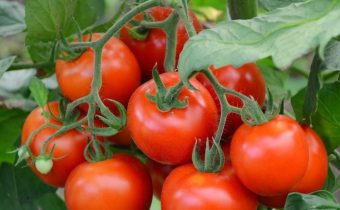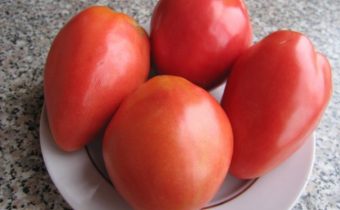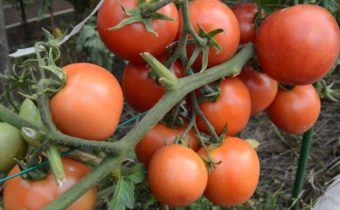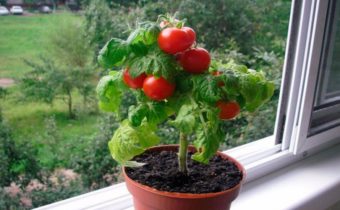Tomato "King of Siberia": a popular variety with a lot of advantages
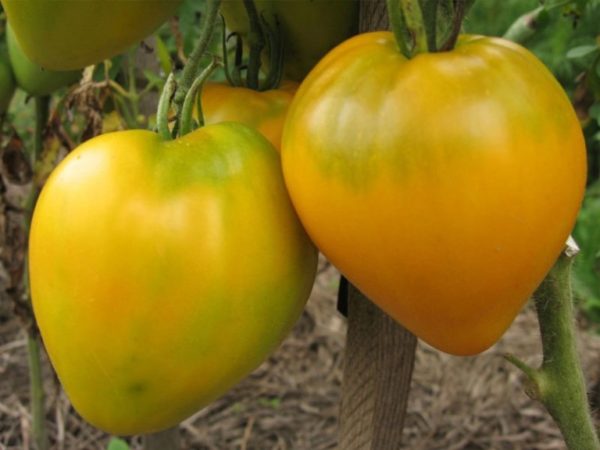
general information
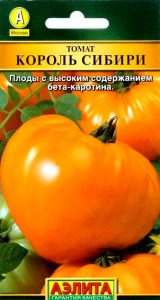 Tomato varieties "King of Siberia" in the register of the Russian Federation, and the neighboring countries (Belarus, Ukraine) no.
Tomato varieties "King of Siberia" in the register of the Russian Federation, and the neighboring countries (Belarus, Ukraine) no.
Agrofirm Aelita brings the variety to the seed market. However, she does not submit data about the originator of the variety, the patent owner or authorship.
Characteristic and description
Filling seeds and describing, “Aelita” presents the variety as an average term of ripening and those who have already grown, fully confirm the terms of ripening of the fruits.
The tomato is recommended for cultivation in film greenhouses, and in this case, the crop can be obtained much earlier, as well as in open ground in private farms of citizens, summer residents and vegetable growers.
Description of the bush
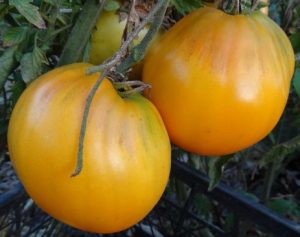 According to reviews, the vegetative form of the plant is tall, indeterminate.
According to reviews, the vegetative form of the plant is tall, indeterminate.
The leaf plate is green, not large, and the whole plant is slightly leafy. The leaf does not prevent tomato fruits from placing a barrel in the sun and being caressed.
The first inflorescence is laid over the 7-9 leaf, then after 2-3.
Fruit
Tomato fruits of this variety are large. The average weight of 250-300 g. The mass of the lower fruits often reaches a weight of 400 g, but such a bush can "give out" 1-2.
Tomatoes heart-shaped. In this case, the lower fruits do not always resemble the shape of the heart, but, the higher, the fruit becomes smaller, but not less than 150 g and certainly “hearty”
Their skin is smooth, without ribbing and green spots at the base.
The fruit is quite dense. After lying for a short time, it becomes a little softer, but many growers complain of excessive dryness.
On the cut visible tomato pulp without clear boundaries of seed chambers.
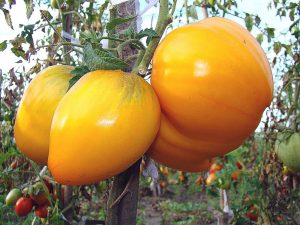 Especially vegetable growers like the taste. Although those who sow their seeds, for many years, claim that when upgrading a variety, they receive fruits with a completely different taste, unlike the old and favorite variety.
Especially vegetable growers like the taste. Although those who sow their seeds, for many years, claim that when upgrading a variety, they receive fruits with a completely different taste, unlike the old and favorite variety.
Aelita claims that tomato fruits have a high content of beta-carotene and other vitamins. That is why the variety is recommended for diet and baby food.
Growing tomatoes "King of Siberia" reviews also indicate that the fruit is tasty and meaty. The balance of sugars and organic acids is so optimal that vegetable growers prefer this variety again and again.
Apply the fruit mainly as a salad. However, surplus products may well be used for the preparation of tomato products. As a disadvantage, we can say that sauces and ketchups will require the addition of other varieties of tomatoes, since the products will be pale, unsaturated in color.
Maturation
The ripening period is extended in time. The variety does not differ in ripening, therefore experienced growers recommend harvesting during the technical ripeness period.
Ripening begins with the lower and largest fruits and gradually moves upwards.
Resistance to pathogens and pests
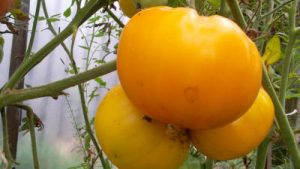 It is not by chance that the variety is named “King of Siberia”. The tomato tolerates temperature fluctuations, as well as deviations from the optimal humidity indicators.
It is not by chance that the variety is named “King of Siberia”. The tomato tolerates temperature fluctuations, as well as deviations from the optimal humidity indicators.
The variety is rarely attacked by fungal infections, even with prolonged cooling and significant rainfall.
Especially love pests to the variety is not noticed.
Those vegetable growers who constantly keep the situation under control and are engaged in regular treatments against fungal diseases, argue that the "King of Siberia" never gets sick.
Advantages and disadvantages
Assessing the variety, vegetable growers do not want to part with a tomato, given its huge advantages:
- large fruits;
- heart shape;
- great taste;
- resistance to external weather factors;
- resistance to pathogens and pests;
- good marketability.
See also: Tomato "Brandy Pink": in detail about its advantages and disadvantages
Cultivation features
 Tomato variety "King of Siberia" average ripening, therefore, to speed up fruiting, you need to sow as soon as possible. If it is not possible to use phytolamps for supplementing, then the optimum time for sowing is the beginning of March.
Tomato variety "King of Siberia" average ripening, therefore, to speed up fruiting, you need to sow as soon as possible. If it is not possible to use phytolamps for supplementing, then the optimum time for sowing is the beginning of March.
When growing it is necessary to take into account that the variety is large-fruited and it needs a lot of nutrients, it means that the preparation of the soil mixture and dressings should be given greater attention.
Growing seedlings
It doesn’t matter how well the seedlings are grown to the envy of tomato yield.
Seed warming
To seedlings appear quickly and together, the seed should be heated. To do this, proceed as follows.
- Tomato seeds are soaked in a solution of manganese (0.1 g per 100 g of water) for 15 minutes;
- Rinse under running water through a strainer;
- We put in wet fabric;
- We wrap in a plastic bag;
- Shipped to a place where the temperature will be within 24-26 C.
Soil mixture
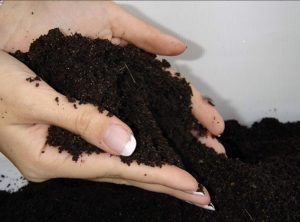 To carry out the sowing correctly and grow the seedlings without additional fertilizing, the soil is bought in a specialty store, or prepared independently according to this recipe:
To carry out the sowing correctly and grow the seedlings without additional fertilizing, the soil is bought in a specialty store, or prepared independently according to this recipe:
- fresh compost - 1/3 bucket;
- ripened humus - 1/3 of a bucket;
- garden soil - 1/3 buckets.
- sand - 1 kg;
- oven ash - 0.5 kg;
- superphosphate - 50 g;
- ammonium nitrate - 50 g
Everything is thoroughly mixed, it is necessary to allow the soil mixture to rest in a non-frozen room for at least 2 weeks.
Sowing
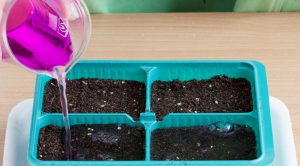 It is possible to sow seeds in the general capacity. To do this, we fill the tub with soil, compact it, and spread the seeds that are hatching on the surface at a distance of 2.5-3 cm from each other.
It is possible to sow seeds in the general capacity. To do this, we fill the tub with soil, compact it, and spread the seeds that are hatching on the surface at a distance of 2.5-3 cm from each other.
Sprinkle with soil 1-1.5 cm and sprinkle with warm water from a spray bottle. Cover with film or glass and set it in a place where the temperature throughout the drain is between 24-26 C.
In 5-6 days, shoots will appear.
Care
As soon as the seedlings of 90% of the seeds are visible, the temperature should be lowered, and the illumination should be increased. Capacity set to the brightest place. The temperature during the day should be 16-18ᵒ C, and at night 12-14 ᵒC. Such an event will not allow sprouts to stretch.
Watering is carried out with warm, separated, better rainwater.
Dive
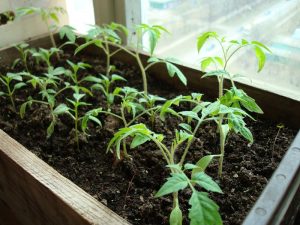 In the phase of the two true leaves, we dive into individual cups. Filling the container with soil in half, take out the sprout and tear off 1/3 of the rootlet. This action will translate the taproot into the fibrous root system, and will increase the area of absorption of nutrients.
In the phase of the two true leaves, we dive into individual cups. Filling the container with soil in half, take out the sprout and tear off 1/3 of the rootlet. This action will translate the taproot into the fibrous root system, and will increase the area of absorption of nutrients.
Having planted a sprout, we sprinkle with earth up to the very cotyledonous leaves and compact the ground. We water.
Since we did not fill the cup completely with earth, this will allow us, as the plant grows, to fill the soil mixture.
Transshipment
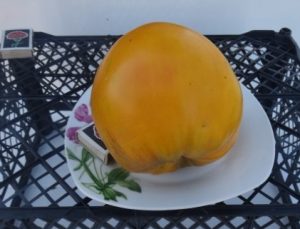 Considering that the “King of Siberia” is a tall and large-fruited tomato, for the seedling period it is necessary for it to increase as much as possible the root system.For this, it is necessary to transfer the plant to a larger tank.
Considering that the “King of Siberia” is a tall and large-fruited tomato, for the seedling period it is necessary for it to increase as much as possible the root system.For this, it is necessary to transfer the plant to a larger tank.
If the tomato was originally dribbled in a capacity of 200 g, then for handling we select 500. After removing the root system, without destroying the earthy coma, we put it in a larger glass and pour the nutritious earth.
This procedure will allow the plant to create an additional root system, and the plant will not be so high. Some growers practice sowing early, and tear off the lower leaves and plant deeply in the ground.
If the plant is again strongly stretched, it is possible to carry out another transfer into a 700 ml capacity.
Transplant into the ground
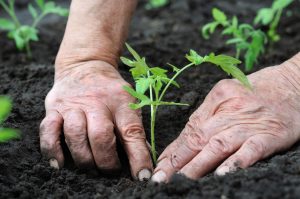 The seedlings ready for transplanting should have a height of 25-30 cm and 7-8 well-developed leaves.
The seedlings ready for transplanting should have a height of 25-30 cm and 7-8 well-developed leaves.
When choosing a landing site, the following requirements are imposed on it, the place should be:
- light;
- protected from the north winds;
- without the solanaceous ancestors;
- not be able to stagnate water.
If there is no desire or ability to feed, the transplant should be carried out in the soil mixture prepared as for seedlings. To do this, a hole is dug at the selected landing site, soil is chosen, and in its place the soil enriched with nutrients is poured. Planted in her seedlings so that the earthy lump on the root system does not lose integrity.
See also: The best varieties of tomatoes for open ground
Care
In order for a tomato to produce all its genetic potential in the form of a crop, careful care of the plantings is necessary.
Watering
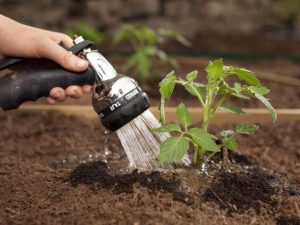 Nutrients through the root system in the vegetative, come only in dissolved form.
Nutrients through the root system in the vegetative, come only in dissolved form.
As soon as the earthen clod under the plant dries out, growth stops, the flowers and buds fall. Plant cells begin to age, the vegetation process ends. That is why maintaining optimum moisture near the root system is the most important thing when caring for tomatoes.
Shaping
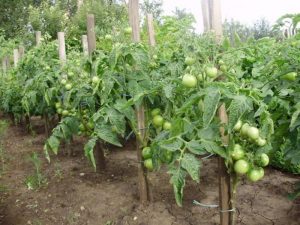 Tall, large-fruited plant form only in one shoot. This means that all stepchildren must be removed at the moment when their value has reached 2-3 cm.
Tall, large-fruited plant form only in one shoot. This means that all stepchildren must be removed at the moment when their value has reached 2-3 cm.
With the planting of seedlings at the same time supports are installed, with which plants will be fixed.
On the garter material also need to take care in advance, because the fruit weighing 400 g or more will not be able to hang on their own shoots and will need fixing.
You need to tie up the plant as the shoot grows.
To speed up the ripening, you can remove a tomato in the technical ripeness phase, and you can already ripen in room conditions.
See also: Tomato "Pertsevidny". Characteristics and description of the variety
By purchasing tomato seeds "King of Siberia" once, in the future you will be able to independently collect seeds and use your planting material.
Video: Siberian open field tomatoes


